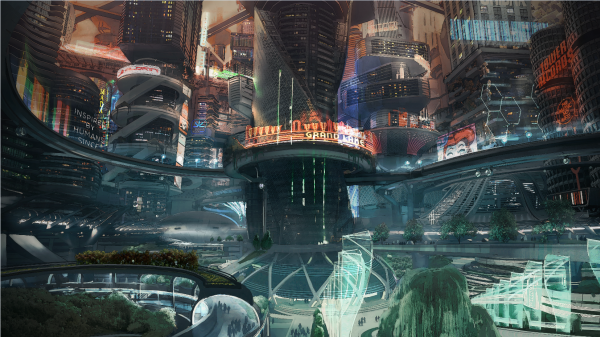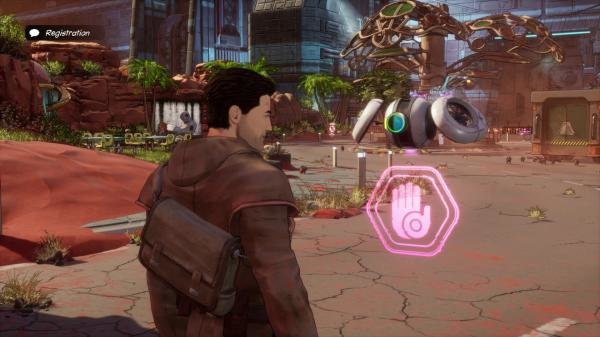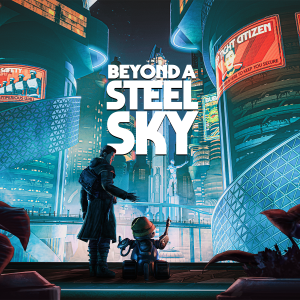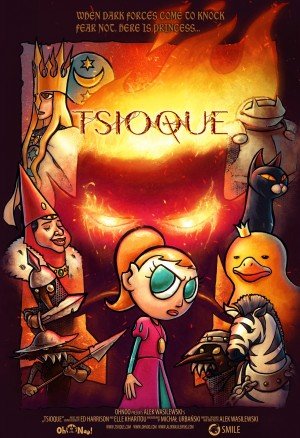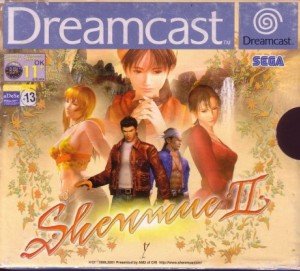Charles Cecil – Beyond a Steel Sky interview
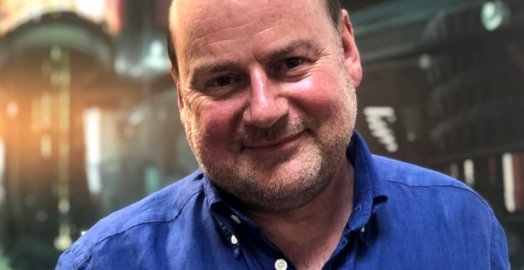
After his talk at devcom / gamescom, I was able to talk to Charles Cecil about Beyond a Steel Sky, the long-awaited but surprisingly different sequel to Revolution’s 1994 sci-fi classic Beneath a Steel Sky. One of the key points that Charles spoke about during his talk was the goal of creating a dynamic world, continuing on from his original concept of the Virtual Theatre System that was first introduced in Lure of the Temptress.
Below is an abbreviated summary from parts of his talk, which provides an intro to the Virtual Theatre System, followed by a transcript of our interview to delve more deeply into the upcoming game.
Virtual Theatre System
The first aspect of this idea was essentially context-sensitive verbs, which we used in Lure of the Temptress back in 1992. An example of this happens with Ratpouch. You could chain commands together to get him to do something for you. However, in practice that was hard.
The second aspect is the characters (NPCs) walking around the world, which makes the world feel dynamic, makes it feel alive. That was already possible even in 1992.
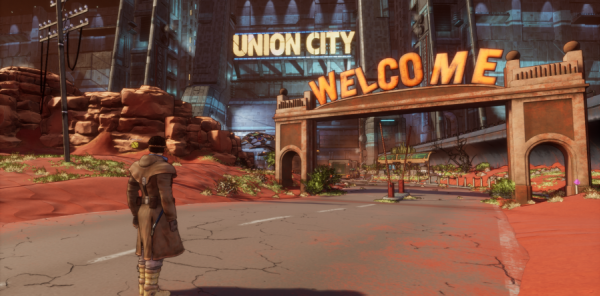
In Beneath a Steel Sky we evolved Virtual Theatre by moving the context-sensitive verbs component into a system like Linc, which allowed you to influence/hack through Virtual Theatre.
An example in BASS was hacking the elevator using Linc by removing the access for Lamb. His intentions were still to travel down, but because you hacked his access he could no longer do this. It changed how he behaved.
Beyond a Steel Sky
A game in realtime 3D, in which Virtual Theatre evolves again. We have a need to thrill, excite and surprise people. The game is written with Dave Gibbons, again, as Art Director.
The core objective for us is to re-use Virtual Theatre, which we didn’t use after BASS(!). We are attempting to write a world in which dynamic characters walk around and you can subvert the AI system (done back in BASS using Linc). We then layer familiar adventure gameplay on this dynamic environment. Using the Unreal Engine, programming complex behaviours now becomes possible.
In Beyond a Steel Sky, the story begins with Robert Foster living in the Gap, where he accepts an invite to go fishing with a friend. While fishing, from the lake a wolf-like stalker machine emerges and knocks him out. When he awakes he decides to follow after his friend who was abducted, and before he knows it he finds himself back at Union City.
Here his first objective is to break into the city, finding a way through puzzles in which you interact with and change the world. An example of the dynamic behaviour is that the birds fly away if you get near, but if you’re holding food for instance they will follow you. A small example of the dynamic element of the Virtual Theatre System.
The second aspect is Linc hacking. While back in BASS you would use it to hack Lamb’s access to the elevator, now there will be other situations. For instance, a drink dispenser can be hacked to swap a command around. Now alarms sound when a valid access is used, and the alarms draw in a drone, which enables you to get into area you couldn’t before. Still adventure puzzles, but a new evolution.
Ultimately, the puzzles must be logical. Slapstick is easy; logic is harder as obvious things must be hidden.
Ivo Teel: Thanks for taking the time, Charles, to speak with Adventure Gamers! When watching the Apple keynote, I was quite positively surprised to see Beyond a Steel Sky in there!
Charles Cecil: In truth, the Apple Arcade made all the difference. Apple is joyful to work with; their partnership is really a great way for us to introduce this to new audiences as well as talking to our current users. Talking directly to our audience ensures we are more in tune with them.
Ivo: Beyond a Steel Sky is an ambitious project, going back to an old IP but working with new technology.
Charles: The original game was very successful, but obviously a lot of people that played games 25 years ago don’t play games anymore. The vast majority of the potential market now wasn’t playing games back then. What we did do is make the game free when ScummVM made it possible to play the game again (it was originally a DOS title). Which was fantastic.
So there is a hardcore base of people who played it originally, but there’s also a lot of people who played it since (becoming free). But we are absolutely determined that you don’t need to know anything about the original game – it will stand on its own. We will convey through the narrative everything you need to know about BASS. That was one of the absolutely vital points.
In many ways, what I hope is that we bring forward a smaller community than Broken Sword but a very passionate community; obviously if people choose to evangelize the game that is great. But by being part of the Apple Arcade program, that gives us an enormous platform. As Apple says, they are the biggest games publisher in the world, so that’s incredibly exciting and we are very flattered that we were invited to be part of that.
Just to be clear, we do have PC and consoles running as well, with PC and Apple Arcade releases to be simultaneous. For Apple Arcade they cover Mac as well as Apple TV and iOS.
Ivo: Can you talk about the decision to go back to the dystopian world of Beneath a Steel Sky, 25 years later? Always a risk associated with it, as it comes with expectations.
Charles: There are, but we needed to balance the risk of taking back an old IP with expectations versus launching a totally new adventure IP, which is very difficult for developers.
The other thing is that I wanted to work with Dave Gibbons again; we talked about that almost since the original BASS. Being able to support the game with a comic book is fantastic; it can set up the story and provide the motivation to the player for the puzzles and understanding what the jeopardy of the protagonist is and build an empathetic relationship with the protagonist.
I do love Broken Sword and writing Broken Sword games, but it’s lovely to take a break and focus on Beyond a Steel Sky.
Ivo: There are going to be some things that are different, while other things are going to be the same. I’ve seen your talk just now, so I have a better understanding, but can you clarify this further for our readers?
Charles: The main characters are the same, slightly older. The robot Robert built himself while he lived outside the city in an area called the Gap, called Joey – one thing we thought fans would certainly feel disappointed about is if he didn’t make a return.
We felt that due to the time scale, it should be set in Union City. What the original game does incredibly well is suggest the scale of the city, even if there were few locations. So we wanted to ensure that we build on that idea of scale, and the ability to see this beautiful city as you fly through it using the pods system.
For example, you go back up to the industrial section at one point. It’s not the pipe factory because if it was that would be super-serving, but in the distance you see that pipe factory. It’s a bonus if you’ve played the original game, rather than a requirement.
Ivo: How do you feel about the response so far to the 3D style?
Charles: We do have a responsibility to give people what they want, but we have to give it in a different way. We can’t just do another point-and-click, we just can’t. It has to evolve and of course there are people that love point-and-clicks and want it, who of course can be negative about the route that we changed. People were negative about the fact that in Broken Sword 5 we pre-rendered our sprites.
All I would say is, it’s not a 2D point-and-click; it can’t be that (not commercially either), but what we're working very hard on is to ensure that the spirit stays the same. The wisecracking Joey, the ability to get him to do things that you can’t for whatever reasons, the drama of the situation. Spoiler alert for the ending of Beneath a Steel Sky The original game ends with Robert finding out it’s his own father who’s behind much of the troubles he’s in. End spoiler. We obviously can’t do that ending again, but hopefully we have a twist that will be every bit as unexpected and dramatic.
Ivo: One thing I didn’t fully understand until your talk just now is the significance of the Virtual Theatre System. Can you elaborate on that?
 Charles: The pure example of Virtual Theatre was the original Lure of the Temptress, and there were several problems with that. First, there was no ability to give people commands layered in with other elements like in BASS. Although on paper it looks fantastic, in reality it just allowed you to send others on jobs you couldn’t do for whatever reason: You don’t quite know why you can’t push the wall down yourself, but you have to get someone else to do it.
Charles: The pure example of Virtual Theatre was the original Lure of the Temptress, and there were several problems with that. First, there was no ability to give people commands layered in with other elements like in BASS. Although on paper it looks fantastic, in reality it just allowed you to send others on jobs you couldn’t do for whatever reason: You don’t quite know why you can’t push the wall down yourself, but you have to get someone else to do it.
Also, athough we had these characters walking around, you don’t choose the subject to talk to them about. All you do is talk to people and then an event rolls over and when you talk to these people the next time they talk about different things and the questions are different.
The way knowledge develops like that is quite clunky. For example, if I wanted to talk about this bottle of water because I picked it up and it was somehow significant to the story, we weren’t able to do that in Lure of the Temptress. Because ultimately only big world events changed what people said.
So that's why when we wrote BASS we limited its use and put in puzzles like where you delink Lamb’s access to the elevator (using Linc), which changes the actions he undertakes, as his motivations are still to take the elevator but he can’t now. That felt very exciting, one of the moments that felt very fresh. You were subverting the system to affect what other characters could do.
Ivo: You’re going to use that in Beyond a Steel Sky, yet you haven’t used it since BASS. What expectations do you have for it?
Charles: As an independent developer, what we were able to do quite some time ago was to come up with a prototype that was very pure in the way that Virtual Theatre and Linc hacking worked. But it was clear that we weren’t conveying the narrative as powerfully as I thought we ought to, which is why we layered the adventure on top of it. Had we been in an agreement with a publisher to finish, we would not have had that ability. Being self-funded gave us incredible freedom and we only really moved forward when we were confident that the balance between these things was right.
Is it the future? I think to an extent, yes, because of what you can do. The principle is that it gives a totally different sense to a game: characters walk around the world clearly driven by motivation, rather than a traditional point-and-click where characters are in a holding pattern and only respond once the player interrupts them.
Ivo: In a traditional adventure game there are moments in which you know you have to do this thing, and you come up with a way for how to do it. But this game has a different way in which it expects you to do that, so you have to spend time figuring out how to also do this new thing. In the example you gave during the talk, a bird might have something in its beak and what you’re trying to achieve is to get it to drop that. There’s many ways you could do that, and traditionally it’s been about how you do it, not what you need to do. You’re trying to turn that around?
Charles: Ooh that’s an interesting way of putting it actually; it’s indeed like that. It’s about what you do rather than how you do it.
Ivo: Could you elaborate on the ‘simulation’ elements as well, as you describe a dynamic world in which people have lives as part of Virtual Theatre.
Charles: I like the word simulation; in a way we are simulating the world, but we are controlling it. At one point I talked about emergent gameplay, but there isn’t true emergent gameplay because we have to script the outcomes. What we can do is have flags, so that a character will respond in two or three ways based on multiple events. I’m wary of using the word emergent, but in the non-pure sense, certainly things will emerge. The term simulation is very nice in that perspective.
Ivo: What role will Joey have in the new adventure, for people that are big fans?
Charles: As before he has multiple shells, with increasingly cool things to do, and you need those to help solve problems!
Ivo: People seem to be apprehensive of the game being 3D and what often comes with that, things like putting action events in.
Charles: I can assure you there are no box-pushing puzzles, as far as action is concerned. There is nothing wrong with action; what you don’t want is to suddenly go from a game that is cerebral and you can sit back and think about it, to one where you suddenly have to press the right button very quickly. We don’t want to do that. I do want to put the player under pressure; I want to have the player ‘die’ if they do the wrong thing, to keep the sense that in this world there is jeopardy.
Ivo: Can you elaborate more on the death concept?
Charles: What I want is to give a sense of jeopardy without people dying; put players under pressure if they don’t respond. As long as they think about it, there is time to figure it out. In Broken Sword 1 and 2 we had death sequences, but it was clear you have a few seconds to respond. Legitimate adventure puzzles, for instance being strangled in Broken Sword 2, you could get killed but had plenty of warning. The solution is there right in front of you. You can play the entire game without ever dying.
Ivo: Will there be an inventory system?
Charles: Oh yes! These are the elements of an adventure game: inventory objects, talking to people, mashing things up, and so on. Like the example I gave on stage, you are Linc hacking, you know what inventory item you’re looking for (a battery in this case) and you know where to get it. The puzzle is set up; you figure it out and get the battery to take back to the truck.
Ivo: Nowadays it seems that puzzles for some need to be easier while others still want them very hard. How are you going to balance that?
Charles: All I can do is ensure that puzzles are logical. Because what happens in this world is driven by motivated and wilful characters (or droids), I hope players will find that as they explore more and try new things, solutions will emerge. I want to get away from this idea of being like a crossword, which is written by one person and you look into their minds and solve the puzzles. Point-and-click adventures are very much like that, as you mentioned earlier. The problem is that if you do something logical that should have solved the problem but it doesn’t work, then the suspension of disbelief is kind of broken. Like hey, that should have worked!
I remember back in Lure of the Temptress, there was a key in the background art (I hadn’t noticed it) and people were very much in disbelief: “How can you have a key there but not let me pick it up!”
Ivo: One major thing that Thimbleweed Park added after release was a hints system. There were several newer players that found the game to be too difficult. Are you thinking of anything like that?
Charles: Oh yes, we absolutely are! But I would hope that as people explore the world, their understanding of it will increase and therefore the understanding of the puzzle emerges. The moment people look up a hint, you again have broken that suspension of disbelief.
In Broken Sword we had a hints system that was very transparent; I think we were the first to do it. Remember the UHS System? I don’t think any other adventures did it; we were first mainstream game that could give you three levels of hints, very inspired by UHS – first a gentle hint and in the end we just said what to do. The problem with that is, the moment you do it, for me I don’t feel as satisfied with the game if I had to look something up. So we’re absolutely thinking of a hint system, but ultimately we want the puzzles to be logical and you feel very immersed in the story.
Ivo: Thanks for taking the time to talk with me, Charles. I know you have a lot planned for today, so I really appreciate you sitting down with me. Good luck with the further development of Beyond a Steel Sky!
Charles: My pleasure!



